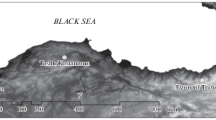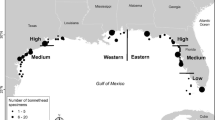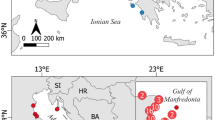Abstract
The Hawaiian hawksbill population has fewer than 20 females nesting per year; hence, there is a need to monitor this population closely and basic biological information on individual growth and age to maturity is critical. We present a skeletochronology analysis of Hawaiian hawksbills using humeri recovered from 30 dead stranded hawksbills, plus 10 dead hatchlings. Growth mark morphology shows readily distinguishable marks similar in appearance to other species, though some animals displayed more diffuse marks. Growth rates remained high (average 2.24–4.77 cm year−1) from 20 to 80 cm straight carapace length (SCL). Hawksbills larger than 80 cm SCL had average growth rates of 0.3 cm year−1. There were few adult turtles in the sample; however, results indicate hawksbills have faster growth rates than loggerhead or green turtles, with probable average age to maturity (at size 78.6 cm SCL) occurring between 17 and 22 years.







Similar content being viewed by others
References
Avens L, Taylor CJ, Goshe LR, Jones TT, Hastings M (2009) Use of skeletochronological analysis to estimate the age of leatherback sea turtles Dermochelys coriacea in the Western North Atlantic. Endanger Species Res 8:165–177
Balazs GH, Chaloupka M (2004) Spatial and temporal variability in somatic growth of green sea turtles (Chelonia mydas) resident in the Hawaiian Archipelago. Mar Biol 145:1043–1059
Bell I, Pike DA (2012) Somatic growth rates of hawksbill turtles Eretmochelys imbricata in a northern Great Barrier Reef foraging area. Mar Ecol Prog Ser 446:275–283
Bell CDL, Parsons J, Austin TJ, Broderick AC, Ebanks-Petrie G, Godley BJ (2005) Some of them came home: the Cayman Turtle Farm headstarting project for the green turtle Chelonia mydas. Oryx 39:137–148
Bjorndal KA, Bolten AB (1988) Growth rates of immature green turtles, Chelonia mydas, on feeding grounds in the southern Bahamas. Copeia 1988:555–564
Bjorndal KA, Bolten AB, Dellinger T, Delgado C, Martins HR (2003) Compensatory growth in oceanic loggerhead sea turtles: response to a stochastic environment. Ecology 84:1237–1249
Boulon RH (1994) Growth rates of wild juvenile hawksbill turtles Eretmochelys imbricata in St. Thomas, United States, Virgin Islands. Copeia 1994:811–814
Caillouet CW, Shaver DJ, Landry AM, Owens DW, Pritchard PCH (2011) Kemp’s ridley sea turtles (Lepidochelys kempii) age at first nesting. Chelonian Conserv Biol 10:288–293
Casale P, Mazaris AD, Freggi D, Vallini C, Argano R (2009) Growth rates and age at adult size of loggerhead sea turtles (Caretta caretta) in the Mediterranean Sea, estimated through capture-mark-recapture records. Sci Mar 73:589–595
Castanet J, Francillon-Vieillot H, Meunier FJ, De Ricqles A (1993) Bone and individual aging. In: Hall BBK (ed) Bone, vol 7, Bone Growth BCRC Press, Boca Raton, pp 245–283
Chaloupka MY, Limpus CJ (1997) Robust statistical modelling of sea turtle growth rates (southern Great Barrier Reef). Mar Ecol Prog Ser 146:1–8
Chaloupka M, Limpus C, Miller J (2004) Green turtle somatic growth dynamics in a spatially disjunct Great Barrier Reef metapopulation. Coral Reefs 23:325–335
Coles WC, Musick JA, Williamson LA (2001) Skeletochronology validation from an adult loggerhead (Caretta caretta). Copeia 2001:240–242
Diez CE, van Dam RP (2002) Habitat effect on hawksbill turtle growth rates on feeding grounds at Mona and Monito Islands, Puerto Rico. Mar Ecol Prog Ser 234:301–309
Francis RICC (1990) Back-calculation of fish length: a critical review. J Fish Biol 36:883–902
Goshe LR, Avens L, Scharf L, Southwood A (2010) Estimation of age at maturation and gowth of Atlatnic green turtles (Chelonia mydas) using skeletochronology. Mar Biol 157:1725–1740
Katsanevakis S, Maravelias CD (2008) Modelling fish growth: multi-model inference as a better alternative to a priori using von Bertalanffy equation. Fish Fish 9:178–187
Klinger RC, Musick JA (1992) Annular growth layers in juvenile loggerhead turtles (Caretta caretta). B Mar Sci 51:224–230
Kobayashi M (2000) An analysis of the growth based on the size and age distributions of the hawksbill sea turtle inhabiting Cuban waters. Jpn J Vet Res 48:129–135
Kobayashi M (2001) Annual cycle of the speckle pattern on the carapace of immature hawksbill turtles (Eretmochelys imbricata) in Cuba. Amphib-Reptil 22:321–328
León YM, Diez CE (1999) Population structure of hawksbill turtles on a foraging ground in the Dominican Republic. Chelonian Conserv Biol 3:230–236
Miller JD (1996) Reproduction in sea turtles. In: Lutz PL, Musick JA (eds) The biology of sea turtles. CRC Press, Boca Raton, pp 51–82
National Marine Fisheries Service and US Fish and Wildlife Service (1993) Recovery plan for hawksbill turtles in the US Caribbean Sea, Atlantic Ocean, and Gulf of Mexico. National Marine Fisheries Service, St. Petersburg
National Marine Fisheries Service and US Fish and Wildlife Service (1998) Recovery plan for US Pacific populations of the hawksbill turtle (Eretmochelys imbricata). National Marine Fisheries Service, Silver Spring
Parker DM, Balazs GH, King CS, Katahira L, Gilmartin W (2009) Short-range movements of hawksbill turtles (Eretmochelys imbricata) from nesting to foraging areas within the Hawaiian Islands. Pac Sci 63:371–382
Peabody FE (1961) Annual growth zones in vertebrates (living and fossil). J Morphol 108:11–62
Piovano S, Clusa M, Carreras C, Giacoma C, Pascual M, Cardona L (2011) Different growth rates between loggerhead sea turtles (Caretta caretta) of Mediterranean and Atlantic origin in the Mediterranean Sea. Mar Biol 158:2577–2587
Seitz WA, Kagimoto KM, Luehrs B, Katahira L (2012) Twenty years of conservation and research findings of the Hawai’i Island hawksbill turtle recovery project, 1989-2009. Technical Report No. 178. The Hawai’i-Pacific Islands Cooperative Ecosystem Studies Unit & Pacific Cooperative Studies Unit, University of Hawai’i, Honolulu, Hawai’i
Shaver DJ, Wibbels T (2007) Head-starting ridley sea turtles. In: Plotkin P (ed) The biology and conservation of ridley sea turtles. Smithsonian Institute Press, Baltimore, pp 297–323
Snover ML (2002) Growth and ontogeny of sea turtles using skeletochronology: methods, validation and application to conservation. Duke University, Dissertation
Snover ML, Hohn AA (2004) Validation and interpretation of annual skeletal marks in loggerhead (Caretta caretta) and Kemp’s ridley (Lepidochelys kempi) sea turtles. Fish Bull 102:682–692
Snover ML, Rhodin AG (2007) Comparative ontogenetic and phylogenetic aspects of chelonian chondro-ossious growth and skeletochronology. In: Wyneken J, Godfrey M, Bels V (eds) The biology of turtles. CRC Press, Boca Raton
Snover ML, Hohn AA, Avens L (2007a) Back-calculating length from skeletal growth marks in loggerhead sea turtles Caretta caretta. Endanger Species Res 3:95–104
Snover ML, Hohn AA, Crowder LB, Heppell SS (2007b) Age and growth in Kemp’s ridley sea turtles: evidence from mark recapture and skeletochronology. In: Plotkin P, Morreale S (eds) The biology and conservation of ridley sea turtles. Johns Hopkins Press, Baltimore, pp 89–105
Snover ML, Hohn AA, Goshe LR, Balazs GH (2011) Validation of annual skeletal marks in green sea turtles (Chelonia mydas) from Hawaii using tetracycline labeling. Aquat Biol 12:197–204
Van Buskirk J, Crowder LB (1994) Life-history variation in marine turtles. Copeia 1994:66–81
Zar JH (1999) Biostatistical analysis. Prentice-Hall, Upper Saddle River
Zug GR, Glor RE (1998) Estimates of age and growth in a population of green sea turtles (Chelonia mydas) from the Indian River lagoon system, Florida: a skeletochronological analysis. Can J Zool 76:1497–1506
Zug GR, Balazs GH, Wetherall JA, Parker DM, Murakawa SKK (2002) Age and growth of Hawaiian green sea turtles (Chelonia mydas): an analysis based on skeletochronology. Fish Bull 100:117–127
Zug GR, Chaloupka M, Balazs GH (2006) Age and growth in olive ridley seaturtles (Lepidochelys olivacea) from the North-central Pacific: a skeletochronological analysis. Mar Ecol 27:263–270
Acknowledgments
We thank Shandell Brunson for her technical assistance with this project, the research partners of the Hawaiian Islands Marine Turtle Stranding Research Network for assistance with obtaining samples, and F. Parrish, K. Van Houtan and two anonymous reviewers for comments on earlier versions of this manuscript. This work complies with all animal experimentation and ethics standards of the USA. All work was performed under and complied with the provisions of Sea Turtle Research Permit TE739350 issued by the U.S. Fish and Wildlife Service. Reference to trade names does not imply endorsement by the authors or their institutions.
Author information
Authors and Affiliations
Corresponding author
Additional information
Communicated by R. Lewison.
Rights and permissions
About this article
Cite this article
Snover, M.L., Balazs, G.H., Murakawa, S.K.K. et al. Age and growth rates of Hawaiian hawksbill turtles (Eretmochelys imbricata) using skeletochronology. Mar Biol 160, 37–46 (2013). https://doi.org/10.1007/s00227-012-2058-7
Received:
Accepted:
Published:
Issue Date:
DOI: https://doi.org/10.1007/s00227-012-2058-7




